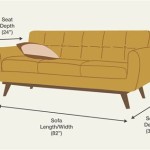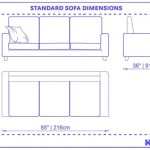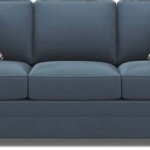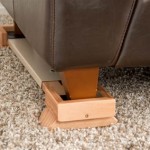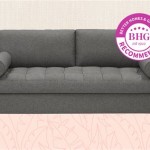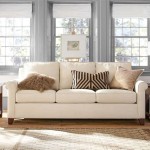Sofa Cushions: Foam or Fibre? A Comprehensive Guide
When choosing sofa cushions, one of the most important decisions is the type of filling to use. Foam and fibre are the two most common options, each offering distinct advantages and disadvantages. This article will delve into the nuances of foam and fibre cushions, examining their characteristics, pros and cons, and suitability for different purposes. Understanding these distinctions will empower you to make an informed decision that aligns with your preferences and requirements.
Foam Cushions
Foam cushions are made from polyurethane foam, a synthetic material known for its resilience and durability. They come in various densities, ranging from soft and plush to firm and supportive. The density of the foam directly impacts its lifespan, with higher-density foams typically lasting longer. Moreover, foam cushions offer excellent shape retention, meaning they resist sagging and maintain their form over time.
Advantages of Foam Cushions:
- Support and Comfort: Foam cushions provide good support, particularly for people with back pain or those who prefer a firmer seating experience. The level of firmness can be tailored to personal preferences by choosing different foam densities.
- Shape Retention and Durability: High-density foam cushions are resistant to sagging and maintain their shape over time. They generally last longer than fibre cushions, making them a more long-term investment.
- Easy Maintenance: Foam cushions are relatively easy to clean. Most spills and stains can be wiped off with a damp cloth, and some foam types are even machine washable.
- Varied Options: Foam cushions come in a wide range of densities and thicknesses, allowing for customization based on individual needs and preferences.
Disadvantages of Foam Cushions:
- Potential for Heat Build-up: Some people find that foam cushions can become warm and uncomfortable in hot weather, particularly if they are dense or thick.
- Limited Breathability: Foam can trap air, making it less breathable than other fillings.
- Can Be Expensive: High-quality foam cushions can be more expensive than fibre cushions.
Fibre Cushions
Fibre cushions, primarily composed of polyester fibres, offer a softer, more plush feel compared to foam cushions. These cushions are typically filled with loose fibres that can be compressed and molded to conform to the body's shape. The level of firmness can be adjusted by varying the density and type of fibre used.
Advantages of Fibre Cushions:
- Softness and Comfort: Fibre cushions provide a soft and comfortable seating experience, often preferred by those who enjoy a less structured feel.
- Breathability and Air Circulation: The loose fibres allow for better air circulation, making fibre cushions cooler and more comfortable than foam cushions.
- Flexibility and Conformity: Fibre cushions can mold to the body's shape, providing a personalized level of comfort.
- Cost-Effectiveness: Fibre cushions are generally more affordable than foam cushions.
Disadvantages of Fibre Cushions:
- Less Support: Fibre cushions offer less support than foam cushions, making them less suitable for individuals seeking firm seating.
- Sagging and Deformation: Over time, fibre cushions can sag and lose their shape, particularly if subjected to heavy use.
- Potentially Difficult to Clean: Loose fibres can be challenging to clean, especially for spills and stains that penetrate the filling.
- Limited Durability: Fibre cushions may not last as long as foam cushions, requiring replacement more frequently.
Considerations for Choosing Between Foam and Fibre
The choice between foam and fibre cushions ultimately depends on individual preferences and lifestyle. Consider the following factors when making a decision:
- Desired Level of Support and Firmness: If you require firm support, foam cushions are the better choice. For a softer, more plush feel, fibre cushions are preferable.
- Usage and Frequency: For high-frequency use and heavier individuals, foam cushions offer greater durability and shape retention. Fibre cushions are suitable for occasional or lighter use.
- Climate and Temperature: Fibre cushions are more breathable and cooler than foam cushions, making them more suitable for warmer climates.
- Budget and Lifespan: Foam cushions can be more expensive but typically last longer than fibre cushions. Fibre cushions offer a more affordable option, but may require replacement more frequently.
In conclusion, understanding the characteristics and pros and cons of both foam and fibre cushions empowers you to make an informed decision that aligns with your individual needs and preferences. Whether you seek firm support, a plush feel, or a balance of both, choosing the right filling ensures optimal comfort and enjoyment of your sofa for years to come.

How To Choose The Right Sofa Cushion

Types Of Pillow Stuffing What S The Best Stated Home Blog

Cushion Care The Sofa Chair Company

Types Of Pillow Stuffing What S The Best Stated Home Blog

Down Vs Foam Sofa Cushions Circle Furniture
Your Guide To Choosing The Right Cushion Filling Dfs

The Best Foam To Use For Sofa Cushions Good Better

Foam Core Vs Pocket Coils In Furniture Which Is Better Theaterseat Blog
Your Guide To Choosing The Right Cushion Filling Dfs

Looking To Buy A Sofa Or Chair Foam Versus Fibre Reviewed Millers

